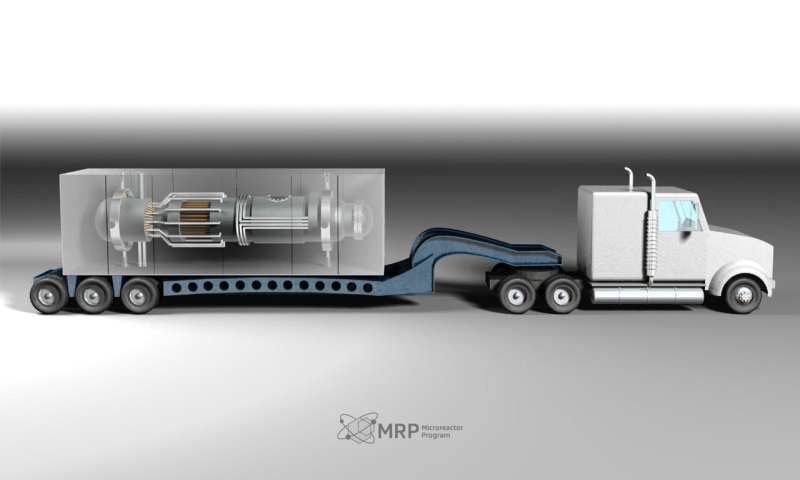Developers seeking to deploy advanced nuclear reactors can find high market potential in states with energy-intensive industries, nuclear-friendly laws, and widespread social acceptance—factors outlined in a new report by researchers at Idaho National Laboratory (INL).
The report, “Microreactor Applications in U.S. Markets,” evaluated state-level legal, regulatory, economic and technology implications for microreactor applications in the U.S., with Alaska and Wyoming as early adopters to deploy advanced nuclear reactors.
“Alaska and Wyoming have their own niche markets, but there is commonality in the remoteness of the applications, mobile uses for microreactors in mining, and energy use for refined products derived from mined sources,” said David Shropshire, an INL nuclear energy economist. He and Steven Aumeier, an INL senior advisor, authored the report along with university partners who are part of the INL-led Emerging Energy Markets Analysis. This report comes on the heels of the 2021 Global Market Analysis for Microreactors.
Markets suitable for microreactors
Microreactors are a subset of small modular reactors with approximate power output in the one to tens of megawatts-electric (MWe) range. The designs are suited for remote industrial applications like seafood processing in Alaska and trona mineral mining in Wyoming. Most microreactor designs would be built in a factory and could ship easily.
The 172-page report summarizes a Department of Energy (DOE) Microreactor Program analysis of the market opportunities for microreactors. It evaluated several energy solutions for each profile market, creating a basis for understanding how different elements stack up to provide value-informed solutions that consider social, environmental, economic and technical dimensions.
For instance, favorable conditions for microreactors include:
- Markets that are cost competitive in electricity and heat, comparable (if not better) in remote locations with diesel sources, and have low-carbon sources including wind, solar, geothermal and energy storage.
- Modular designs that allow transport to remote locations by road, barge or rough airstrips.
- Replacement of coal sites with infrastructure in place.
- Areas where transport costs are very high and subject to access restrictions for portions of the year due to weather.
The Energy Market Analysis team examined the regulatory climate in each of the 50 states in terms of openness to nuclear power, the economic assessment of heat markets that could be important to microreactor adoption, and the potential preferences for microreactor designs.
Most states have either removed barriers for microreactor deployment or established carbon-reduction goals that make advanced nuclear technologies attractive. Yet challenges remain, such as public perceptions about microreactors’ uncertainties in terms of costs, waste and fuel management. The report suggests the nuclear industry and national labs increase communication about the technology and create a clear differentiation between microreactors, small modular reactors and large reactors.
The DOE Microreactor Program performs research and development to reduce uncertainty and risk in the design and deployment of microreactors that help enable commercialization.
“Microreactors are a new technology to many of the potential deployment sites, so it is important to promote common understanding of the barriers to market entry for both developers of the technology as well as end users,” said John Jackson, national technical director of the DOE Office of Nuclear Energy’s Microreactor Program.
“The DOE programs support broad availability of energy solutions to meet individual needs, and characterization of these needs is very valuable.”
Future research
The report also outlined areas needing further research, including developing a deeper understanding of public acceptance or resistance to microreactors. Other outstanding questions indicate the need to:
- Evaluate other possible microreactor markets including conventional mining, oil and gas extraction operations, carbon refining, ammonia production, synthetic fuels, and other industries.
- Evaluate the cross-jurisdictional regulatory considerations for land use, siting, carbon reduction, transmission corridors and mining.
- Research the regulatory issues associated with industry use of microreactors, and the access to and interconnection with the grid or the ability to sell excess power into deregulated markets.
- Examine and develop business models for using microreactor heat under different scenarios such as for industrial heat and power, a community distributed heat system, or electric heating.
- Evaluate the microreactor supply chain to evaluate tax and incentive packages for manufacturers, workforce training and job analysis.
- Evaluate considerations for siting microreactors in northern latitudes, such as permafrost considerations, district heating, economic impacts from opening the Northwest Passage, use of microreactors for emergency management and disaster response, and analysis of critical mineral extraction and refining.

